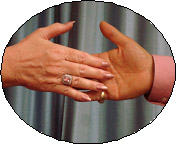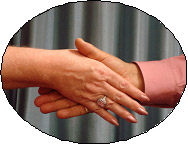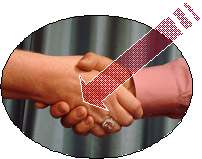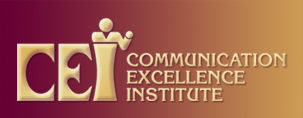Of all the aspects of communication we inherit bad information about from our parents, relatives, and friends growing up, it’s how to give a proper handshake. We don’t shake hands with our parents. We may hug them, but we don’t shake hands. And even if we did, most of them wouldn’t know how to teach us anyway. The proof is in the following common poor handshakes:
The “Bone-Crusher”
This is the most dangerous of all the handshakes. If you’re on the receiving end, you feel like your hand is in a vise. It’s usually accompanied by a vigorous pumping action. Not only does it hurt people in our own culture, but it’s especially painful in cultures such as Hispanic, where handshakes are much lighter. It’s also excruciating to anyone with arthritis or another condition of the hand. This one is definitely to be avoided
The “Fingertip” Handshake
This is the handshake we get from childhood, when we obviously can’t grip someone’s hand very hard. Women get it from outdated social expectations, when they were expected to shake hands softly. Men can even get it from the “continental” practice of kissing a woman’s fingers as part of the handshaking ritual. No matter the source, it conveys weakness, uncertainty, and affectation.
The “Wet Fish”
Universally disliked, this one looks just like it sounds: a floppy sloppy, often damp, attempt at a grasp that leaves the other person only guessing how to return the gesture. Along with conveying the feelings of the “Fingertip,” this one adds a kind of smarminess and even disdain. You wouldn’t offer this handshake to your worst enemy!
Note: Speaking of dampness, some people have moister than normal hands. What to do, if this is you? Just discreetly carry a handkerchief and use it to dry your hands just before doing significant handshaking.
The “You Poor Thing”
Otherwise known as the “two-handed” handshake, this variety involves engaging one hand with the other person’s hand, then placing the other hand on top, creating a comforting enclosure. Common at funerals, this handshake is meant as solace for the bereaved. In any other setting, it means “I want something more than just a business relationship with you.” While there’s a good motive behind this handshake (being warmer, friendlier, and sympathetic), in business, avoid it at all costs.
The “I’m the boss, applesauce”
This one has the initiator grasp your hand then turn his or her hand over, pushing your hand underneath. This is a naked power gesture masquerading as friendliness. Another one to avoid.
The “I’m the boss, applesauce” has a variant frequent in politics, and is a favorite of our current President. A person starts to shake hands in the normal way, then grasps your lower or upper arm with his or her other hand. Just another way to assert control and dominance.
So much for the familiar poor handshakes. Now let’s look at the anatomy of a great, warm handshake.
Start by aiming the web between your thumb and forefinger toward the other person’s web

Then be sure to get the two webs contacting one another (sometimes we have to wiggle our hands a little to work our way into good contact).

Finally, gently press your bottom three fingers against the back of the other person’s hand.

This handshake has several advantages over the others.
- You get a good grip on the other person’s hand, sending messages of confidence and strength.
- You convey warmth with a “wrap-around” feel.
- You easily adjust to handshakes from cultures that don’t practice the typical American crusher handshake.
- You avoid making people uncomfortable who have arthritis or other medical conditions in their hands.
- You can shake more hands without getting tired. (Lyndon Johnson could have used this one. It was reported that his hands actually bled from shaking many hands in rapid succession.)
Try this handshake and you’ll be blown away by how well it works!
Yours in good communication,
Jan and Neal Palmer |



